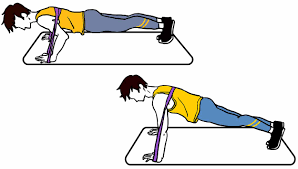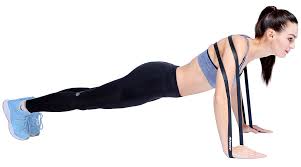Push-ups should be a mainstay in your upper body workouts if you want a well-rounded fitness regimen. You can use pushups to supplement your bench training. Your weights can soar if you add a resistance band to them. You can learn how to do resistance band push-ups by reading this article.
Why Should You Do Push-Ups With Resistance Bands?
It Provides Support
The hardest part of a push-up, in the opinion of many, is, well, pushing your body back up from the ground. The resistance band hack is useful here: using the mini band in this way serves as a support to help you lift your body weight.
The band crosses your chest once you lower your body. As a result, the resistance of the band cooperates with you to provide a slight lift as you push back up.
It Promotes Good Form
The effort required to perform a push-up can occasionally prevent us from doing so correctly. For instance, we might allow our elbows to flare or our hips to sag in order to make up for a lack of strength.
However, you can concentrate and improve your technique by lightly easing your load by looping a mini band above your elbows.
In particular, this tip makes it easier to maintain your chest support, which enables you to keep your back flat throughout the exercise and perfect the perfect push-up.
The band’s resistance also prevents elbows from flaring out, which is a common mistake that puts pressure on the shoulders and may lead to pain in the future. Your range of motion will even improve as you begin to hone your push-up posture.
It Strengthens Your Triceps
Your triceps can also benefit greatly from training if you wear a small band above your elbows. That’s because the band, which keeps your elbows tucked in tightly, positions your body to specifically target your triceps. Your triceps are engaged and forced to work harder by this narrower arm position.
It Boosts Confidence
The mini band hack will not only give your body a little extra lift, but it also might give you a little boost in spirits. They are unable to even attempt push-ups or benefit from their many physical advantages because of their lack of confidence.
However, the mini band hack will also assist you in developing confidence in your capacity to carry out (and eventually perfect) standard push-ups.
How To Do Resistance Band Push-Ups?
It is a great idea to add resistance to the exercise when the body weight version becomes too simple. By doing so, you’ll put the pushing muscles through a mental and physical challenge that will encourage them to build muscle mass and become stronger.
An ideal push-up with resistance bands can be achieved by following these 5 steps:
- Loop the band through the palms of your hands after placing it around your back and underneath your arms.
- Just slightly more than shoulder-width apart, place your palms on the ground. Try to align your hands so that they are roughly shoulder height.
- So that your spine is straight, raise yourself into a high plank position. To stay in this stable plank position, tense your glutes, quads, and core.
- Bending at the elbows will help you to descend. The lower you can go without losing form, the better, as that will give you a greater stretch. Stop when your arms are at least 90 degrees. A good stopping point is when your nose is just above the floor or about a fist’s height off the ground.
- With your arms fully extended, push up to the starting position from the bottom position by pressing through the heels of your palms. This constitutes a full rep.

How To Adjust The Intensity?
Normally, you wouldn’t switch up the push-up variation every time you did them as part of your workout. However, as you gain strength, you’ll need to work harder if you want to keep improving.
When using resistance bands, you have some special options for adjusting the resistance and, consequently, the intensity that you wouldn’t have with other equipment like weights. The following push-up techniques are the most effective:
Shorten The Band
One of the biggest advantages of resistance bands is that you can increase the amount of resistance you have to move against by simply shortening a band. Wrapping the band around one or both of your hands is the simplest way to do it for push-ups. Do it before descending from the push-up position.
Use More Than One Band
There is no restriction on how many bands you can wear at once. You will be able to precisely adjust the resistance by using multiple bands. A collection of bands with various resistance levels is very useful in this situation.
Lower The Exercise Speed
It’s not the only way to up the intensity of a set; resistance can also be increased. The alternative strategy involves using the same resistance while moving more slowly through each repetition.
Greater total time under tension, as a result, will greatly encourage your body to strengthen itself. With this method, you might even need to reduce the resistance.
Add A Pause
The earlier approach has a relative in this. You can only add a pause in specific places during the movement rather than slowing down the entire movement. At that point, the chest muscles are fully extended and put to the test.
However, adding a pause in the top position is also a great idea since we use resistance bands. It will be difficult for your entire body to remain still in this position because the band will be pulling you the hardest.
Try A High Rep Count
Increasing the intensity by adding resistance or making each rep harder and harder isn’t always the best strategy for progress. You can try taking a step back if you’re having trouble increasing your push-up totals or if you’ve reached a plateau.
Actually, each set should have more reps and less resistance. The supporting muscles, tissues, and organs like joints and tendons will all become stronger as a result.
Can Resistance Band Push-Ups Build Muscle?
A standard push-up performed without the use of a resistance band is a fantastic, time-tested exercise for developing your chest, shoulders, and triceps. The inability to increase the load means that bodyweight exercises do have some limitations in terms of muscle growth.
That’s not to say that you can’t continue to build muscle with push-ups, as you can do other forms of progressive overload like increase reps, increase volume, decrease rest, and increase intensity (i.e. clapping push-ups or slowing down tempo).
But eventually, it becomes challenging to grow in size. Basically, bodyweight exercises like push-ups have a lower upper limit for muscle growth.
With bands, you can use the same progressive overload techniques (which are crucial for building strength and hypertrophy), but you can also increase the load, which gives you an edge in terms of muscle growth.
Naturally, it isn’t as simple as it is with free weights because you can’t gauge your weight and increase it in precise increments. Banded pushups, however, are still very effective and will undoubtedly speed up your ability to gain muscle mass.
Resistance bands are also less strenuous on the joints than free weights and weighted vests, making them a safer alternative.
Overall, resistance bands are a must-have training tool if you are following a bodyweight exercise routine because they can enhance your hypertrophy and strength training in a variety of ways.
Resistance band pushups are still highly advised even if you use free weights because they train your muscles differently and increase shoulder/scapula resilience and stability. Pushups also help you gain relative strength because they let you press without a bench, which trains your muscles differently.
So even though you may bench press, pushups are still necessary. Switching things up is a good idea whether you are a beginner or a pro. If you lift weights, add some resistance band pushups to the end of your workout to completely exhaust your pushing muscles.
